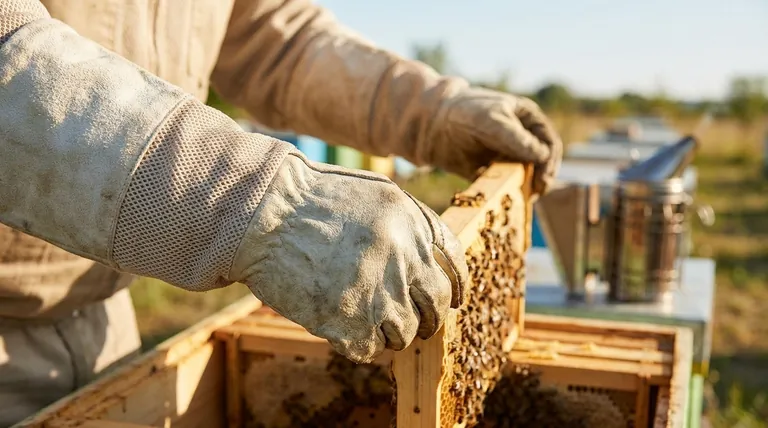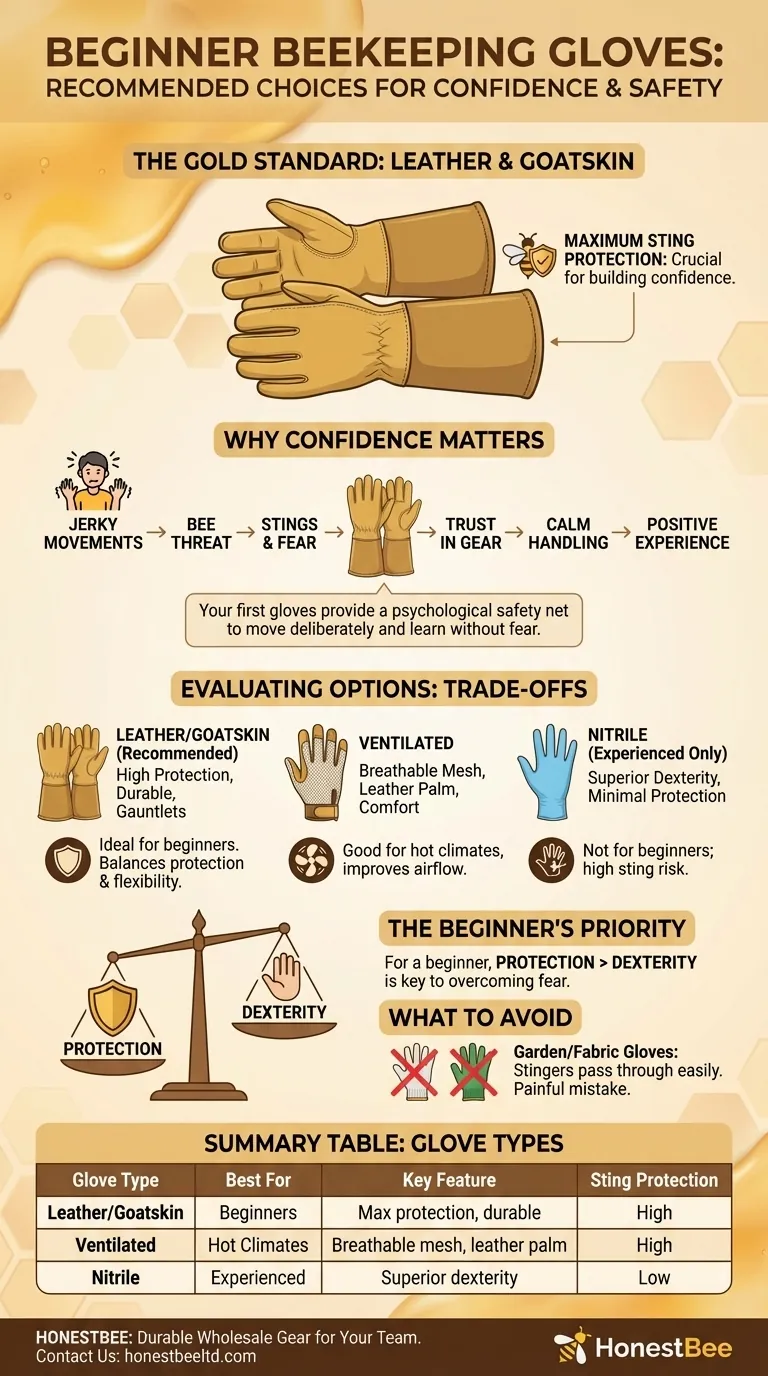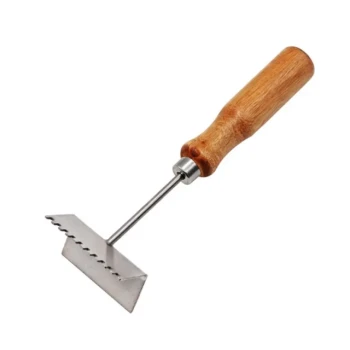For a beginner in beekeeping, the most recommended gloves are those made of thick, durable materials like leather or goatskin. These gloves offer the highest level of sting protection, which is crucial for building the confidence needed to handle bees calmly and effectively. While they may feel slightly clumsy at first, the security they provide is invaluable during the initial learning phase.
Your first pair of gloves isn't just about preventing stings; it's about managing fear. The right gloves provide the psychological safety net you need to move deliberately and learn the craft without the constant anxiety of getting stung, which is the most common hurdle for new beekeepers.

Why Your First Gloves Are About Confidence
New beekeepers are naturally nervous. This nervousness can lead to jerky, sudden movements, which bees interpret as a threat. A reliable pair of gloves breaks this cycle.
The Foundation of Calm Handling
When you trust your equipment, you can focus on the bees. Feeling secure allows you to perform inspections with smooth, gentle motions, which keeps the colony calm and reduces the likelihood of defensive behavior in the first place.
Preventing a Negative First Impression
Getting stung on the hands during your first few hive inspections can be a significant setback, creating fear and hesitation for future work. A highly protective glove almost completely eliminates this risk, ensuring your initial experiences are positive and educational.
Evaluating Your Glove Options
While leather is the top recommendation, it's important to understand the different materials and their specific benefits.
Leather and Goatskin: The Gold Standard
Leather, particularly goatskin, is the ideal choice for a beginner. Goatskin offers an excellent balance of high sting resistance and superior flexibility compared to thicker, stiffer cowhide. Most of these gloves feature long canvas or leather gauntlets that extend to the elbow, ensuring your arms are also protected.
Ventilated Gloves: A Comfort Upgrade
Ventilated gloves are a variation of leather gloves. They typically feature a goatskin palm for protection and dexterity but include a thick mesh fabric on the back of the hand. This design significantly improves airflow, keeping your hands cooler and more comfortable during inspections on hot days.
Nitrile Gloves: The Dexterity-First Choice
Some beekeepers prefer using thick, disposable nitrile gloves. Their primary advantage is superior dexterity, allowing you to feel frames and handle equipment with precision. However, they offer minimal sting protection and are not recommended until you have gained significant experience and confidence.
Understanding the Trade-offs
Choosing a glove involves balancing key factors. For a beginner, the decision should be straightforward.
Protection vs. Dexterity
This is the central conflict in glove selection. Thicker leather gloves offer maximum protection but reduce your sense of touch. Thinner nitrile gloves offer maximum dexterity but minimal protection.
For a beginner, protection is far more important than dexterity. You will quickly adapt to the feel of leather gloves, but you cannot easily overcome the fear that comes from being stung.
The Importance of a Proper Fit
An ill-fitting glove is both unsafe and frustrating. Gloves that are too tight will restrict your movement and stretch the material, making it easier for a bee's stinger to penetrate. Gloves that are too loose can slip off or get caught on equipment, and they create gaps where bees can enter.
Always measure your hands according to the manufacturer's sizing chart before buying.
What to Avoid: Garden and Fabric Gloves
Never use thin cotton, canvas, or standard gardening gloves for beekeeping. A bee's stinger can easily pass through these materials. Using inadequate protection is one of the most common and painful mistakes a new beekeeper can make.
Making the Right Choice for Your First Season
Your initial investment in protective gear is an investment in your beekeeping education and enjoyment.
- If your primary focus is maximum safety and building confidence: Choose a pair of high-quality goatskin gloves with long, integrated gauntlets.
- If you will be working in a very hot climate: Prioritize a ventilated glove that combines a leather palm with a breathable mesh back for better comfort.
- If your budget is the primary constraint: You can use thick nitrile gloves, but you must accept the significantly higher risk of stings and the potential impact on your confidence.
Ultimately, your first pair of gloves should empower you to work with your bees safely, calmly, and effectively.
Summary Table:
| Glove Type | Best For | Key Feature | Sting Protection |
|---|---|---|---|
| Leather/Goatskin | Beginners | Maximum protection, durable | High |
| Ventilated | Hot climates | Breathable mesh, leather palm | High |
| Nitrile | Experienced beekeepers | Superior dexterity | Low |
Ready to gear up with confidence? HONESTBEE supplies durable, high-protection beekeeping gloves and equipment to commercial apiaries and distributors. Our wholesale-focused operations ensure you get reliable gear that keeps your team safe and productive. Contact us today to discuss your needs!
Visual Guide

Related Products
- Vented Beekeeping Jacket with Hood and Veil for Beekeepers
- 3 Layer Mesh Vented Sting Proof Beekeeping Suit with Hat and Veil
- Cotton Beekeeping Suit and Round Hat with Veil Bee Keeper Protective Gear
- Yellow Plastic Bucket Pail Perch for Beekeeping
- Long Langstroth Style Horizontal Top Bar Hive for Wholesale
People Also Ask
- What features should be considered for sting protection in a beekeeping suit? Ensure Total Safety and Comfort
- What should be considered when purchasing a ventilated bee suit? Ensure Maximum Safety and Comfort
- Why is it important to close all zips and fasten buttons before washing a beekeeping suit? Protect Your Suit & Your Safety
- Why is it important to regularly clean a beekeeping suit? Prevent Bee Attacks and Protect Your Investment
- What are the benefits of a fully ventilated beekeeping suit? Stay Cool and Protected in Hot Climates



















